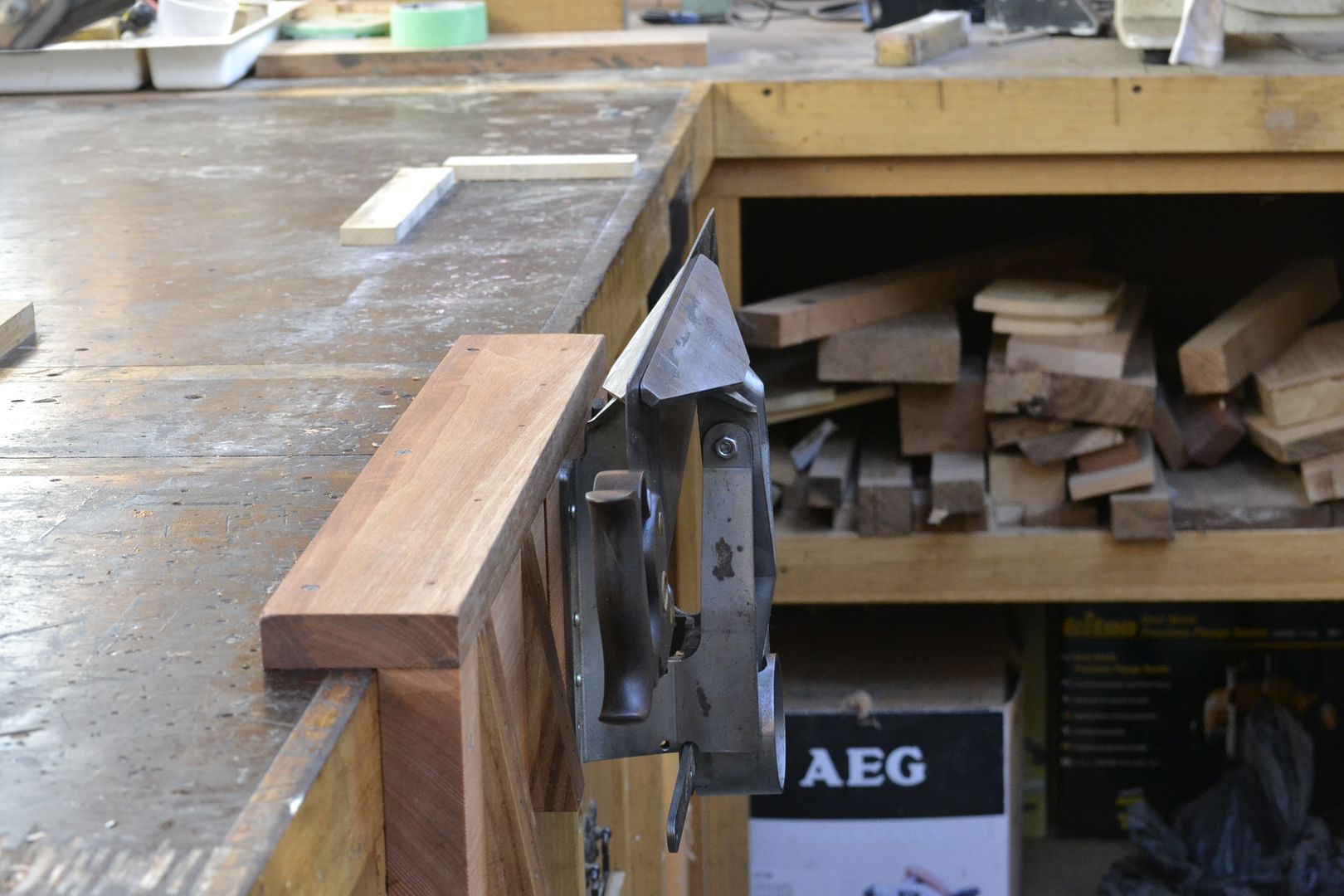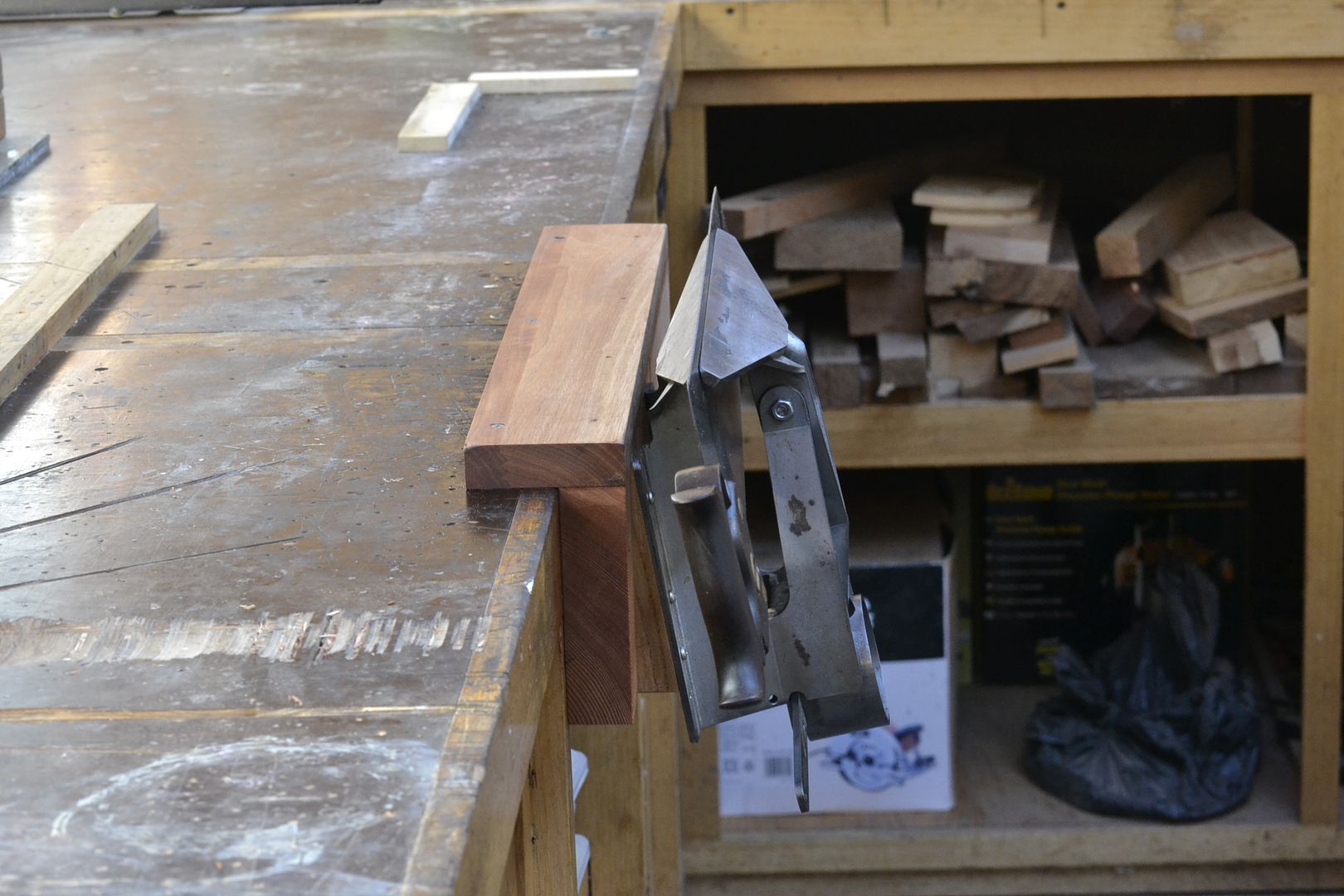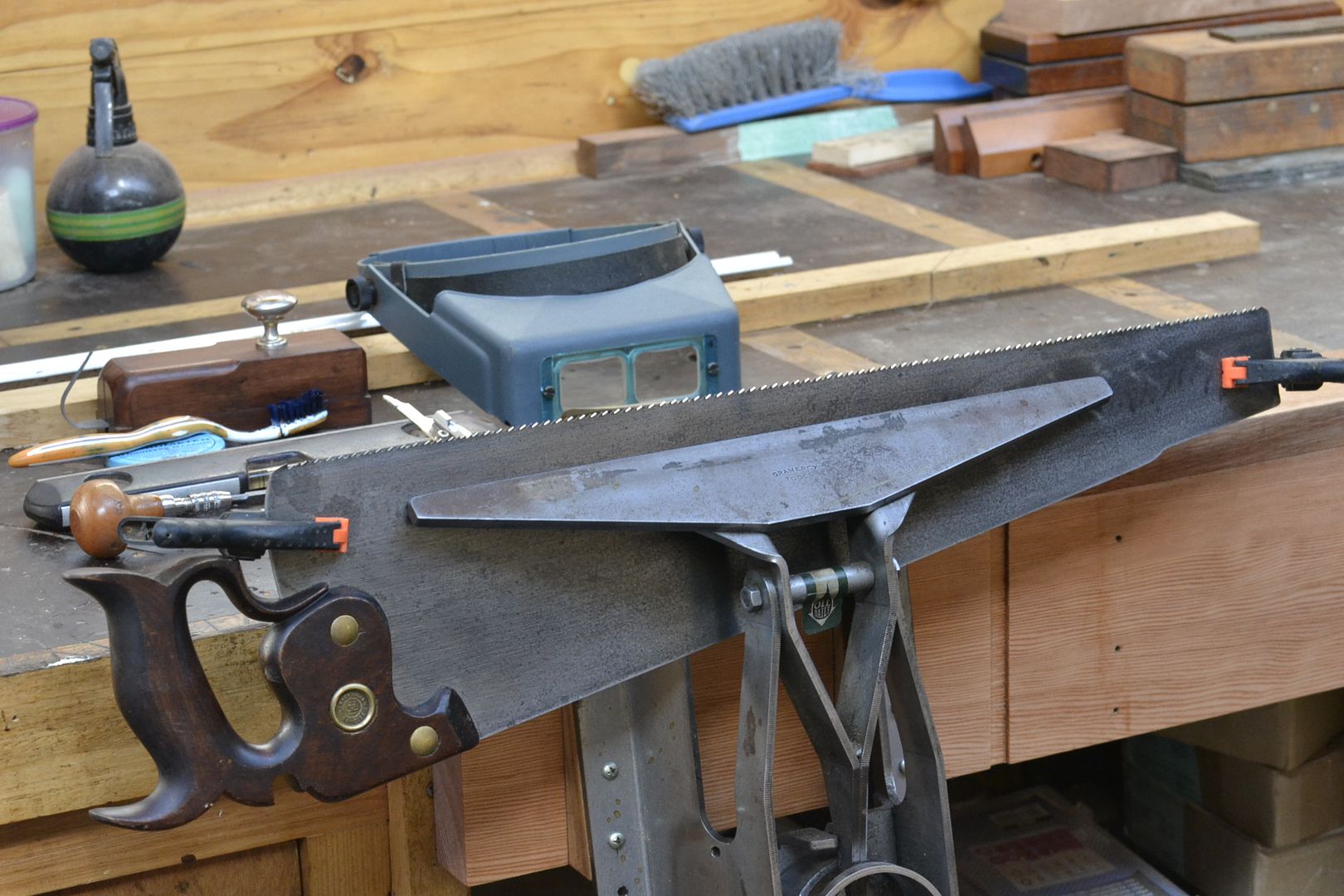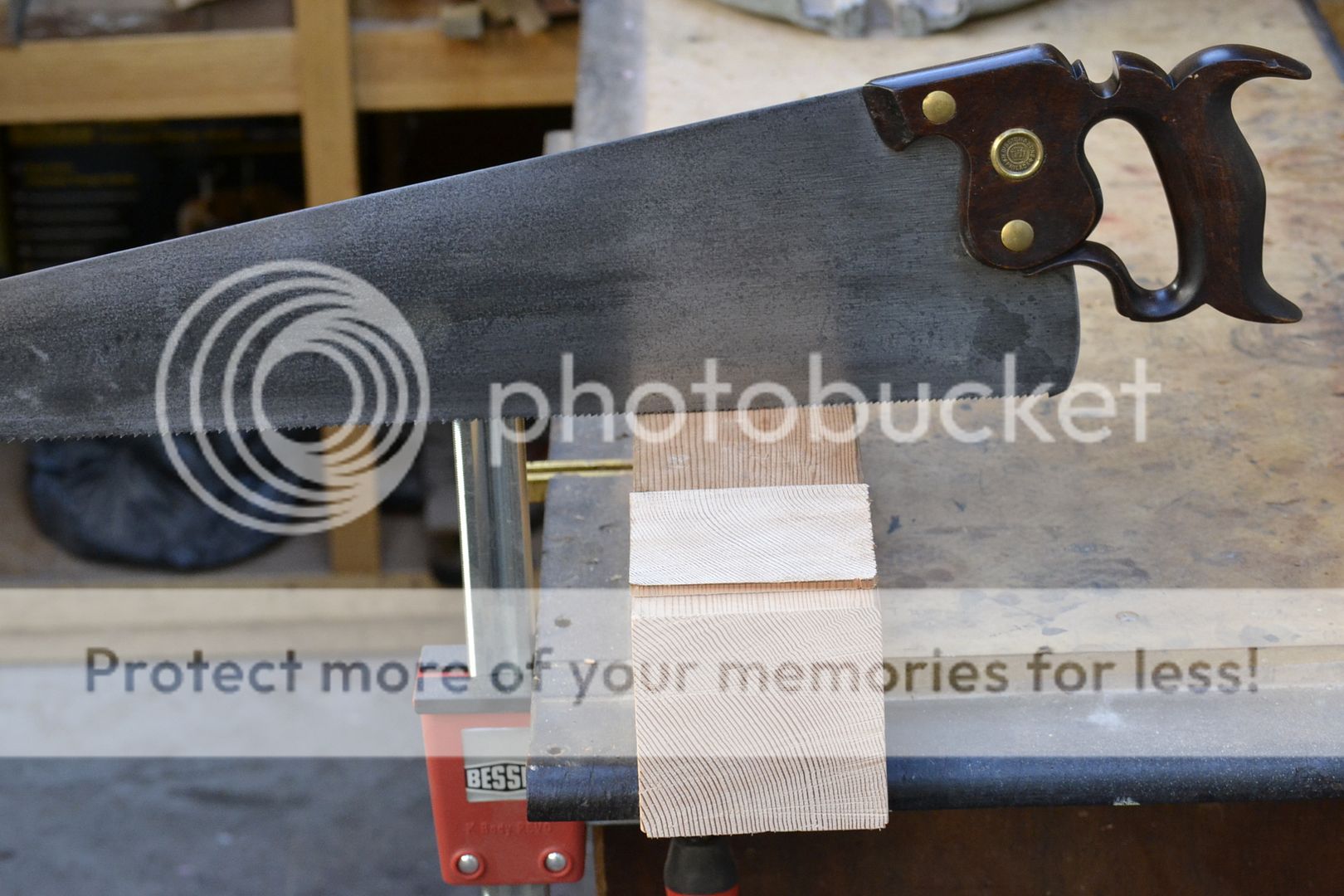You are using an out of date browser. It may not display this or other websites correctly.
You should upgrade or use an alternative browser.
You should upgrade or use an alternative browser.
Hand Saw Sharpening.
- Thread starter swagman
- Start date

Help Support UKworkshop.co.uk:
This site may earn a commission from merchant affiliate
links, including eBay, Amazon, and others.
matthewwh
Established Member
What a great idea, simple and effective.
Love it!
=D>
Love it!
=D>
swagman
Established Member
Brent Beach has written an excellent article on the subject of Sloped Gullets;
http://www3.telus.net/BrentBeach/sawjig ... llets.html
http://www3.telus.net/BrentBeach/sawjig ... llets.html
You don't have to bother with a sloping gullet, just file a bit of a deeper tooth if you want one. The sloped vs. flat part is of little to no consequence. I've had saws filed both ways (sloped and flat) and the difference is less than dramatic, hardly noticeable. The Disston material mentioned a fast crosscut sawing which implies roughing out parts. If you want to crosscut rapidly then just use a rip-filed saw which Tage Frid advocated well before any of the message board references to sloped gullets mentioned in the Beach article (see his two-volume series and FW articles from the 1970s and 80s). There is a dramatic difference here. Barring that, just use your gardener's bow saw with replaceable blades. They do rough crosscuts with no trouble at all, and with speed, and you can leave your relatively 'fine-ish' filed 10ppi crosscut (or finer) saws well enough alone. And sloped vs. flat doesn't apply at all to coarse rip saws whose teeth and gullets are already large enough.
The flat vs. sloped gullet argument can be filed along with the assertion that corrugated plane bottoms slide easier over certain species. They probably do, a little, but the difference is so slight that in the grand scheme it matters not a bit. It's compelling when you contemplate that there seems to be a lot less metal in contact with the wood therefore the work should be demonstrably easier. The only problem is that it is not.
The flat vs. sloped gullet argument can be filed along with the assertion that corrugated plane bottoms slide easier over certain species. They probably do, a little, but the difference is so slight that in the grand scheme it matters not a bit. It's compelling when you contemplate that there seems to be a lot less metal in contact with the wood therefore the work should be demonstrably easier. The only problem is that it is not.
Depending on the posture one chooses to assume when filing a saw, a tilting saw vise actually makes it easier to file dead straight across. It is sometimes nice to rest one's left elbow on the sharpening bench (right-handed worker), the left hand holding to front of the saw file. A tilting vise makes this more comfortable and again easier to file a flat gullet in that position. A tilting saw vice, in order to file a sloping gullet, is as gimped up as tilting a dovetailed work piece so that the angled tail cuts can be made vertically -- best just to learn how to angle the saw for the cut, same for a saw file if you believe the canard that sloping gullets are a daylight to dark sort of thing, just angle the file.
IMO, the most important thing when filing a saw, and I am by no means an expert, is to have the teeth level therefore preventing an errant tooth or two from ragging out the back of the cut and generally making the work harder than it should be, and the result poorer than it should be. I'd rather work with a slightly duller saw, but with perfectly level teeth, than one blisteringly sharp fresh from a filing with a couple of high teeth.
IMO, the most important thing when filing a saw, and I am by no means an expert, is to have the teeth level therefore preventing an errant tooth or two from ragging out the back of the cut and generally making the work harder than it should be, and the result poorer than it should be. I'd rather work with a slightly duller saw, but with perfectly level teeth, than one blisteringly sharp fresh from a filing with a couple of high teeth.

£199.00
£360.17
Trend Portable Benchtop Router Table with Robust Construction for Workshop & Site Use, 240V, CRT/MK3
Amazon.co.uk

£10.10
£15.48
Portwest Browguard with Clear Visor, Size: One Size, Colour: Clear, PW91CLR
Amazon.co.uk

£15.99 (£1.60 / count)
£27.44 (£2.74 / count)
3M 8822 Disposable-fine dust mask FFP2 (10-pack)
Amazon.co.uk

£16.99
£19.99
Respirator Mask,Safety Dust Face Cover,Dust Face Cover Paint Face Cover,Gas Mask With Filter,For Paint,Dust And Formaldehyde,Sanding,Polishing,Spraying And Other Work
ShenZHEN CIRY MINGYANG LITIAN ELECTRONIC ECOMMERCE

£34.99 (£3.50 / count)
£39.99 (£4.00 / count)
VonHaus Chisel Set - 10pcs Woodworking Tools Set - Wood Carving Tools, Wood Chisel Sets with Sharpening Stone, Honing Guide and Storage Case
VonHaus UK

£49.91
£58.33
Mefape Mortise and Tenon Jig Tools for Woodworking Routers, Tenon Cutter, Manual Mortising Machine, Invisible Slotting Machine Jig Stand, 3-Axis Guide Rail for Adjust Trimming Length and Width
wangshijuntianjinhongyuegongyipin

£9.99 (£1.00 / count)
£14.45 (£1.44 / count)
JSP M632 FFP3moulded Disposable Dustmask (Box of 10) One Size suitable for Construction, DIY, Industrial, Sanding, dust protection 99 Percent particle filtration Conforms and Complies to EN 149
Amazon.co.uk

£10.19 (£0.39 / count)
£11.99 (£0.46 / count)
Nicpro Carpenter Pencil with Sharpener, Mechanical Carpenter Pencils Set with 26 Refills, Case, Deep Hole Marker Construction Pencils Heavy Duty Woodworking Pencils for Architect (Black, Red)
NicproShop EU
swagman
Established Member
Charles; that hand saw within the attached photos is going to be filed with sloping gullets.
matthewwh
Established Member
Of course sloping gullets work, they physically increase the amount of gullet space available between the teeth and make the 60 degree angle slightly more acute so you get a deeper gullet bottom and therefore increase the thickness of timber that can be can be cut with a given pitch. The steep gullets on Japanese saws serve the same purpose, as do skip teeth and hook teeth on bandsaw blades.
If tested on timber that is within the range of both saws you won't see any difference, it would be like comparing the top speed of two cars by driving them both at 50mph.
If tested on timber that is within the range of both saws you won't see any difference, it would be like comparing the top speed of two cars by driving them both at 50mph.
I've crosscut 12/4 rough, down to 4/4 rough, North American hardwoods with professionally sharpened saws and noticed no appreciable difference in sloping vs. flat gullets. If there were a bona fide difference then virtually nobody would ever have filed flat gullets, or if they had done so they would have immediately noticed the marked difference and have gone right back to the sloped variety and flat gullets would have died out a few hundred years ago at least. Sloped gullets died out for a reason - extra tedium for little if any reward. Stuff that works tends to stick around and doesn't need to be 'rediscovered.' If it were just hands down the best way to sharpen a saw then it would have stuck, or certainly stuck well enough that it wouldn't have had to re-emerge on some obscure woodworking listserv here in the States. There are a few older articles on saw sharpening from Fine Woodworking that mention sloped gullets (Harold Payson comes to mind) but just as many that don't. The Payson article probably predates the Rec.Woodworking threads Beach mentions in his article. Sharpening plane irons and chisels on sandpaper most assuredly predates Steve LaMantia's coining of the term 'Scary Sharp' on the Rec. Woodworking listserv, Old Tools, or whatever.
Otherwise, I couldn't care less how the Japanese do much of anything with regard to woodworking. I appreciate the precision to which they work, though it's no greater than better Western woodworking in reality, but that's about it. I don't believe they owe much if any of this precision to sawing with a slope gulleted saw. I think they believe their tools have a soul, too. So take it for what it's worth. I understand that Japanese carpenters love Western rip saws to death, but that doesn't mean much either.
Otherwise, I couldn't care less how the Japanese do much of anything with regard to woodworking. I appreciate the precision to which they work, though it's no greater than better Western woodworking in reality, but that's about it. I don't believe they owe much if any of this precision to sawing with a slope gulleted saw. I think they believe their tools have a soul, too. So take it for what it's worth. I understand that Japanese carpenters love Western rip saws to death, but that doesn't mean much either.
Beach's page is long, it has a lot of hypotheticals on it. Did I miss a conclusion somewhere that a saw was filed with the same fleam and rake, and there was a performance difference perceived by someone who uses a lot of saws?
This topic was a forum-on-fire kind of thing in the states at one point when an ebay seller started filing saws with the sloped gullets and a bunch of engineers got a hold of the notion and they were off to the races. Tarted up $50 saws were all of the sudden $250, and terms like "race saw" were used.
And then it disappeared like a fart in the wind.
If disston preferred it, there must've been a reason for it. By the time their 1950s guide came along, it was missing despite them talking about saw filing.
I'd like to see someone provide some sort of proof that it's worth it. I've got a ball joint vise that I've used to do it a couple of times, but I'd have to file two dozen saws to make any real conclusion. Like anyone else who uses saws, I notice when a saw is too grabby, when it's got too much fleam (and rasps wood rather than severing it) or too little fleam (when it cuts aggressively and really blows out a cut).
I cross cut a beech billet yesterday, it was 4x6. It hardly took any time because I used a rip saw. I don't recall cross cutting anything in the recent past where I wanted the saw to be faster - I want the cut to be on the line. If it needs to cut faster, I'll lean on it a little.
This topic was a forum-on-fire kind of thing in the states at one point when an ebay seller started filing saws with the sloped gullets and a bunch of engineers got a hold of the notion and they were off to the races. Tarted up $50 saws were all of the sudden $250, and terms like "race saw" were used.
And then it disappeared like a fart in the wind.
If disston preferred it, there must've been a reason for it. By the time their 1950s guide came along, it was missing despite them talking about saw filing.
I'd like to see someone provide some sort of proof that it's worth it. I've got a ball joint vise that I've used to do it a couple of times, but I'd have to file two dozen saws to make any real conclusion. Like anyone else who uses saws, I notice when a saw is too grabby, when it's got too much fleam (and rasps wood rather than severing it) or too little fleam (when it cuts aggressively and really blows out a cut).
I cross cut a beech billet yesterday, it was 4x6. It hardly took any time because I used a rip saw. I don't recall cross cutting anything in the recent past where I wanted the saw to be faster - I want the cut to be on the line. If it needs to cut faster, I'll lean on it a little.
Not surprisingly folks who file saws for a fee love sloped gullets (sell the sizzle!) almost as much as they love charging $50 for what otherwise is 20 minutes worth of work, tops.
CStanford":50xpbyx3 said:Not surprisingly folks who file saws for a fee love sloped gullets (sell the sizzle!) almost as much as they love charging $50 for what otherwise is 20 minutes worth of work, tops.
Presume that requires shipping a saw two ways, too? Yuck. There's not a lot of saws that I'd pay $75 for.
D_W":3fea3uh1 said:CStanford":3fea3uh1 said:Not surprisingly folks who file saws for a fee love sloped gullets (sell the sizzle!) almost as much as they love charging $50 for what otherwise is 20 minutes worth of work, tops.
Presume that requires shipping a saw two ways, too? Yuck. There's not a lot of saws that I'd pay $75 for.
Me either.
swagman
Established Member
matthewwh
Established Member
Nice one Stewie.
$250 on a 'Buy it now' with free shipping then....?
$250 on a 'Buy it now' with free shipping then....?
bugbear
Established Member
Sloping the file (never mind the gullet) makes it behave as if it's narrower than the 60° you get when it's horizontal; this makes the gullets deeper/bigger.
(more maths, I'm afraid)
BugBear
(more maths, I'm afraid)
BugBear
woodbrains
Established Member
Hello,
Tenon saws have difficulty getting rid of the sawdust. I would suggest anything that makes bigger gullets on small teeth would be a boon. If you only have one tenon saw, it is unlikely to be a rip toothed one, a hybrid or crosscut one would certainly benefit from slope introduced to the teeth.
Mike.
Tenon saws have difficulty getting rid of the sawdust. I would suggest anything that makes bigger gullets on small teeth would be a boon. If you only have one tenon saw, it is unlikely to be a rip toothed one, a hybrid or crosscut one would certainly benefit from slope introduced to the teeth.
Mike.
bugbear
Established Member
woodbrains":19jn2lr3 said:Hello,
Tenon saws have difficulty getting rid of the sawdust. I would suggest anything that makes bigger gullets on small teeth would be a boon. If you only have one tenon saw, it is unlikely to be a rip toothed one, a hybrid or crosscut one would certainly benefit from slope introduced to the teeth.
Mike.
I suspect the intersection set of "people who sharpen their own saws" and "people who have only one tenon saw"
is a very small one.
BugBear
woodbrains":3098k6ix said:Hello,
Tenon saws have difficulty getting rid of the sawdust. I would suggest anything that makes bigger gullets on small teeth would be a boon. If you only have one tenon saw, it is unlikely to be a rip toothed one, a hybrid or crosscut one would certainly benefit from slope introduced to the teeth.
Mike.
I'm curious as to why one would have a "hybrid" saw if they only had one saw. I'd much prefer having a rip saw. I can't actually remember the last time I got out a crosscut saw for small work like cabinet M&T, because a fine toothed dovetail saw works so well for that. I have two crosscut tenon saws, one is a specialty saw for plane making, and the other is a larger saw that's suitable for larger work (14" saw with 11 teeth per inch). I don't know that I've ever even thought about this - it just seems faster cutting all of those parts around a tenon with a single saw. I'd hate to cut the rip side of those tenons with a crosscut filed saw, though.
Sharp trumps all and all of these so-called problems people seem to be having or anticipate having or are scared they will have (slow crosscuts, tenon saws getting bogged down in their own dust, etc.) are largely a figment of the imagination, but if real go completely away with a sharp, straight saw with even teeth. A rip-filed tenon saw might be three strokes faster than a sharp, not too fine crosscut tenon saw. The improvements with all of the things being mentioned in this thread are well at the margins, if effectively nonexistent. The most compelling reason to file a fine-toothed saw to a rip pattern is that it's a lot easier to do so and therefore the user will be more likely to keep it sharp and not have to maintain a redundant inventory of saws while others are out being sharpened.
Similar threads
- Replies
- 3
- Views
- 694





























